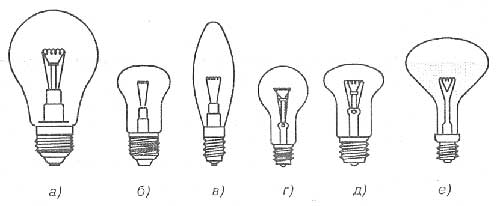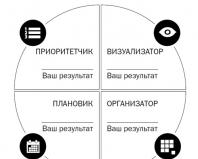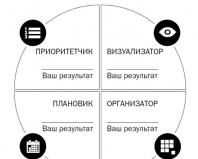Tungsten lamps. Electric lamp: diagram, device, description and reviews
Incandescent lamp
Incandescent lamp - electrical source light, in which a filament body (refractory conductor), placed in a transparent evacuated or filled with an inert gas vessel, is heated to a high temperature due to the flow through it electric current, as a result of which it emits in a wide spectral range, including visible light. The filament body currently used is mainly a spiral of tungsten-based alloys.
Operating principle
The lamp uses the effect of heating the conductor (incandescent body) when electric current flows through it ( thermal effect of current). The temperature of the filament increases sharply after the current is turned on. A filament body emits electromagnetic thermal radiation in accordance with Planck's law. The Planck function has a maximum, the position of which on the wavelength scale depends on temperature. This maximum shifts with increasing temperature towards shorter wavelengths (Wien's displacement law). To obtain visible radiation, the temperature must be on the order of several thousand degrees. At a temperature of 5770 (the temperature of the surface of the Sun), the light matches the spectrum of the Sun. The lower the temperature, the lower the proportion of visible light, and the more “red” the radiation appears.
Part of consumed electrical energy an incandescent lamp converts into radiation, part of which is lost as a result of the processes of heat conduction and convection. Only a small fraction of the radiation lies in the region of visible light, the main share comes from infrared radiation. To increase the efficiency of the lamp and obtain the most “white” light, it is necessary to increase the temperature of the filament, which in turn is limited by the properties of the filament material - the melting point. A temperature of 5771 K is unattainable, because at this temperature any known material melts, collapses and ceases to conduct electric current. Modern incandescent lamps use materials with maximum temperatures melting - tungsten (3410 °C) and, very rarely, osmium (3045 °C).
To assess this quality of light, color temperature is used. At temperatures of 2200-3000 K typical for incandescent lamps, a yellowish light is emitted, different from daylight. IN evening time"warm" (< 3500 K) свет более комфортен и меньше подавляет естественную выработку мелатонина , важного для регуляции суточных циклов организма и нарушение его синтеза негативно сказывается на здоровье.
In ordinary air at such temperatures, tungsten would instantly turn into oxide. For this reason, the filament body is placed in a flask, from which air is pumped out during the manufacturing process of the lamp. The first ones were made using vacuum; currently only lamps low power(for lamps general purpose- up to 25 W) are produced in a evacuated flask. The bulbs of more powerful lamps are filled with an inert gas (nitrogen, argon or krypton). The increased pressure in the bulb of gas-filled lamps sharply reduces the rate of evaporation of tungsten, due to which not only the service life of the lamp increases, but it is also possible to increase the temperature of the incandescent body, which allows increasing efficiency and bringing the emission spectrum closer to white. The bulb of a gas-filled lamp does not darken as quickly due to the deposition of filament body material as in a vacuum lamp.
Design
Design of a modern lamp. In the diagram: 1 - flask; 2 - flask cavity (vacuumed or filled with gas); 3 - filament body; 4, 5 - electrodes (current inputs); 6 - hooks-holders of the filament body; 7 - lamp leg; 8 - external link of current lead, fuse; 9 - base body; 10 - base insulator (glass); 11 - contact of the bottom of the base.
The designs of incandescent lamps are very diverse and depend on the purpose. However, the common elements are the filament body, bulb and current leads. Depending on the characteristics of a particular type of lamp, filament holders of various designs can be used; lamps can be made baseless or with bases various types, have an additional external flask and other additional structural elements.
In the design of general-purpose lamps, a fuse is provided - a link made of a ferronickel alloy, welded into the gap of one of the current leads and located outside the lamp bulb - usually in the leg. The purpose of the fuse is to prevent destruction of the bulb when the filament breaks during operation. The fact is that in this case, an electric arc occurs in the rupture zone, which melts the remaining filament; drops of molten metal can destroy the glass of the flask and cause a fire. The fuse is designed in such a way that when an arc is ignited, it is destroyed under the influence of an arc current significantly exceeding rated current lamps. The ferronickel link is located in a cavity where the pressure is equal to atmospheric pressure, and therefore the arc easily goes out. Due to their low effectiveness, their use has now been abandoned.
Flask
The bulb protects the filament body from exposure to atmospheric gases. The dimensions of the bulb are determined by the rate of deposition of the filament body material.
Gas environment
The bulbs of the first lamps were evacuated. Most modern lamps are filled with chemically inert gases (except for low-power lamps, which are still made vacuum). Heat losses arising due to thermal conductivity are reduced by choosing a gas with a large molar mass. Mixtures of nitrogen N2 with argon Ar are the most common due to their low cost; pure dried argon is also used, less often krypton Kr or xenon Xe (molar masses: N2 - 28.0134 / mol; Ar: 39.948 g / mol; Kr - 83.798 g/mol; Xe - 131.293 g/mol).
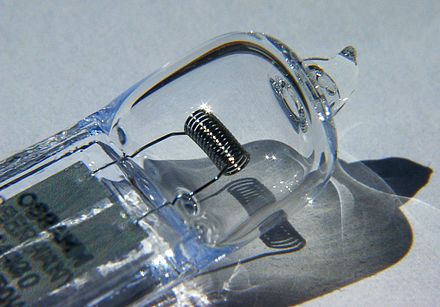
Halogen lamp
The filament body of the first lamps was made of coal (sublimation temperature 3559 °C). Modern lamps use almost exclusively filaments made of tungsten, sometimes an osmium-tungsten alloy. To reduce the size of the filament body, it is usually given the shape of a spiral; sometimes the spiral is subjected to repeated or even tertiary spiralization, obtaining a bispiral or trispiral, respectively. The efficiency of such lamps is higher due to reduced heat loss due to convection (the thickness of the Langmuir layer decreases).
Electrical parameters
Lamps are manufactured for various operating voltages. The current strength is determined by Ohm's law ( I=U/R) and power according to the formula P=UI, or P=U²/R. Since metals have low resistivity, to achieve such resistance a long and thin wire. The wire thickness in conventional lamps is 40-50 microns.
Since when turned on the filament is at room temperature, its resistance is an order of magnitude less than the operating resistance. Therefore, when turned on, a very large current flows (ten to fourteen times the operating current). As the filament heats up, its resistance increases and the current decreases. Unlike modern lamps, early incandescent lamps with carbon filaments worked on the opposite principle when turned on - when heated, their resistance decreased and the glow slowly increased. The increasing resistance characteristic of the filament (as the current increases, the resistance increases) allows the use of an incandescent lamp as a primitive current stabilizer. In this case, the lamp is connected in series to the stabilized circuit, and the average current value is selected so that the lamp operates at full intensity.
In flashing lamps, a bimetallic switch is built in series with the filament. Due to this, such lamps independently operate in flickering mode.
Base
In the USA and Canada, different sockets are used (this is partly due to a different voltage in the networks - 110 V, so different sizes of sockets prevent accidental screwing in of European lamps designed for a different voltage): E12 (candelabra), E17 (intermediate), E26 (standard or medium ), E39 (mogul). Also, similar to Europe, there are bases without threads.
Nomenclature
According to their functional purpose and design features, incandescent lamps are divided into:
- general purpose lamps(until the mid-1970s, the term “normal lighting lamps” was used). The most widespread group of incandescent lamps intended for general, local and decorative lighting. Since 2008, due to the adoption by a number of states of legislative measures aimed at reducing production and limiting the use of incandescent lamps for the purpose of energy saving, their production began to decline;
- decorative lamps, produced in shaped flasks. The most common are candle-shaped flasks with a diameter of approx. 35 mm and spherical with a diameter of about 45 mm;
- local lighting lamps, structurally similar to general-purpose lamps, but designed for low (safe) operating voltage - 12, 24 or 36 (42) V. Area of application - hand-held (portable) lamps, as well as local lighting lamps in production premises(on machines, workbenches, etc., where accidental lamp breakage is possible);
- illumination lamps, produced in painted flasks. Purpose - illumination installations of various types. As a rule, lamps of this type have low power (10-25 W). Flasks are usually colored by applying a layer of inorganic pigment to their inner surface. Less commonly used are lamps with bulbs painted on the outside with colored varnishes (colored tsaponlac), their disadvantage is the rapid fading of the pigment and shedding of the varnish film due to mechanical stress;
- mirror incandescent lamps have a specially shaped flask, part of which is covered with a reflective layer ( thin film thermally atomized aluminum). The purpose of mirroring is spatial redistribution luminous flux lamps in order to use it most effectively within a given solid angle. The main purpose of mirror LNs is localized local illumination;
- warning lights used in various lighting devices (means of visual display of information). These are low power lamps designed to last a long time. Today they are being replaced by LEDs;
- transport lamps- an extremely wide group of lamps designed to work on various Vehicle ah (cars, motorcycles and tractors, airplanes and helicopters, locomotives and carriages railways and subways, river and sea vessels). Characteristics: high mechanical strength, vibration resistance, use special plinths, allowing you to quickly replace lamps in cramped conditions and, at the same time, preventing the lamps from spontaneously falling out of the sockets. Designed for power from onboard electrical network vehicles (6-220 V);
- spotlight lamps usually have high power (up to 10 kW; previously lamps up to 50 kW were produced) and high luminous efficiency. Used in lighting devices for various purposes(lighting and light signaling). The filament spiral of such a lamp is usually laid out more compactly in the bulb due to a special design and suspension for better focusing;
- lamps for optical instruments , which include those mass-produced until the end of the 20th century. lamps for film projection equipment have compactly laid spirals, many are placed in specially shaped flasks. Used in various devices ( measuring instruments, medical equipment, etc.);
Special lamps
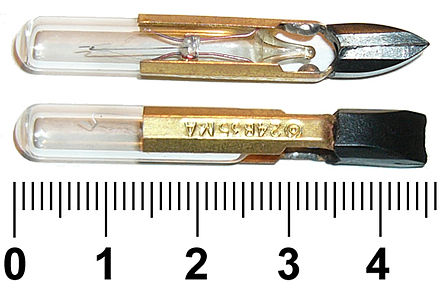
Incandescent switch lamp (24V 35mA)
History of invention
Lodygin's lamp
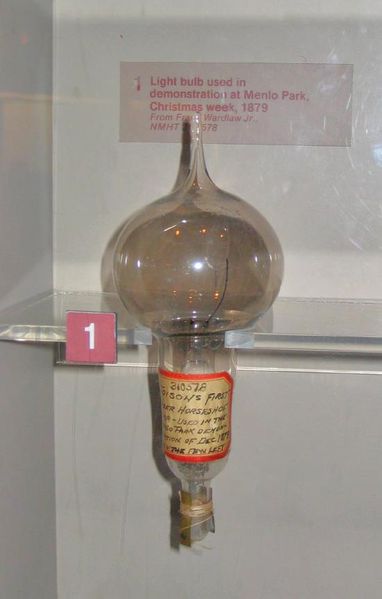
Thomas Edison's lamp with a carbon fiber filament.
Efficiency and durability
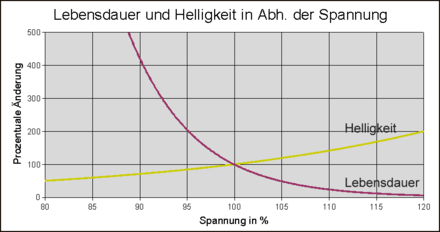
Durability and brightness depending on operating voltage
Almost all the energy supplied to the lamp is converted into radiation. Losses due to thermal conductivity and convection are small. However, only a small range of wavelengths of this radiation is accessible to the human eye. The bulk of the radiation lies in the invisible infrared range and is perceived as heat. Coefficient useful action incandescent lamps reaches its maximum value of 15% at a temperature of about 3400. At practically achievable temperatures of 2700 (regular 60 W lamp), the efficiency is 5%.
As the temperature increases, the efficiency of an incandescent lamp increases, but at the same time its durability decreases significantly. At a filament temperature of 2700, the lamp life is approximately 1000 hours, at 3400 only a few hours. As shown in the figure on the right, when the voltage increases by 20%, the brightness doubles. At the same time, the lifetime is reduced by 95%.
Reducing the supply voltage, although it reduces efficiency, but increases durability. So, lowering the voltage by half (for example, when connected in series) reduces the efficiency by about 4-5 times, but increases the lifetime by almost a thousand times. This effect is often used when it is necessary to ensure reliable emergency lighting without special requirements for brightness, for example, on staircase landings. Often for this purpose when eating alternating current the lamp is connected in series with a diode, due to which current flows into the lamp only during half the period.
Since the cost of electricity consumed during the service life of an incandescent lamp is tens of times higher than the cost of the lamp itself, there is an optimal voltage at which the cost of the luminous flux is minimal. The optimal voltage is slightly higher than the nominal voltage, so methods for increasing durability by lowering the supply voltage are absolutely unprofitable from an economic point of view.
The limited lifetime of an incandescent lamp is due to a lesser extent to the evaporation of the filament material during operation, and to a greater extent to the inhomogeneities that arise in the filament. Uneven evaporation of the filament material leads to the appearance of thinned areas with increased electrical resistance, which in turn leads to even greater heating and evaporation of the material in such places. When one of these constrictions becomes so thin that the filament material at that point melts or completely evaporates, the current is interrupted and the lamp fails.
The greatest wear on the filament occurs when voltage is suddenly applied to the lamp, so its service life can be significantly increased by using various types of soft-start devices.
The tungsten filament has a cold state resistivity, which is only 2 times higher than the resistance of aluminum. When a lamp burns out, it often happens that the copper wires that connect the base contacts to the spiral holders burn out. So, a regular lamp is 60
How does an incandescent lamp work?
The retro light bulb is a beautiful thing, no doubt about it. But how does it all work? How is an Edison light bulb different from a regular light bulb? To be honest, almost nothing. Now let's put everything on the shelves.
First the definition.Incandescent lamp- Light source , in which light is emitted by a spiral, also known as an incandescent filament, also known as a filament body, heated by electric current to a high temperature. The most commonly used spiral is made of refractory metal, for example tungsten , or carbon thread. To prevent oxidation of the filament upon contact with air, it is placed in a vacuum, pumping out the air from the glass flask.
Operating principle
Any incandescent lamp, whether ordinary or retro, uses the effect of heating the conductor as it flows through it. electric current. The filament temperature rises after a short circuit electrical circuit. To obtain visible radiation, it is necessary that the temperature of the emitting body exceed 570 degrees (the temperature at which the red glow begins, visible to the human eye in the dark). For human vision, the optimal, physiologically most convenient, spectral composition of visible light corresponds to radiation with a surface temperature of the solar photosphere of 5770 K. However, unknown solids, capable of withstanding the temperature of the solar photosphere without destruction, therefore the operating temperatures of incandescent lamp filaments lie in the range of 2000-2800 C. The filament bodies of modern incandescent lamps use refractory and relatively inexpensive tungsten ( melting temperature 3410 °C), rhenium and (very rarely) osmium. Therefore, the spectrum of incandescent lamps is shifted to the red part of the spectrum. Only a small fraction of electromagnetic radiation lies in the region of visible light, the bulk comes from infrared radiation and is perceived as heat. The lower the temperature of the filament body, the smaller the proportion energy supplied to the heated wire is converted into useful visible radiation, and the more “red” the radiation seems. Accordingly, retro light bulbs differ from regular topics, which heats up the filament less. Due to this, the filament evaporates more slowly and functions longer.
Retro light bulbs, by the way, are also useful. At temperatures of 2200–2900 K typical for incandescent lamps, yellowish light is emitted, different from daylight. In the evening, “warm” (< 3500 K) свет более комфортен для человека и меньше подавляет естественную выработку melatonin, important for the regulation daily cycles body (disruption of its synthesis negatively affects health).
IN atmospheric air At high temperatures, tungsten quickly oxidizes, forming a characteristic white coating on the inner surface of the lamp when it loses its seal. For this reason, the tungsten filament body is placed in a sealed flask, from which air is pumped out during the manufacturing process of the lamp. Also found, even more often, are gas-filled lamps: in them the bulb is filled with an inert gas - usually argon Increased pressure in the bulb of gas-filled lamps reduces the rate of evaporation of the tungsten filament. This not only increases the life of the lamp, but also allows the body temperature of the filament to increase. Thus, the light Efficiency increases, and the emission spectrum approaches white. Inner surface The bulb of a gas-filled lamp darkens more slowly when the filament body material is sprayed during operation, like a evacuated lamp. Retro light bulbs are usually made with vacuum bulbs, but some manufacturers make them gas-filled.
Design
Construction of an incandescent lamp. In the diagram: 1 - flask; 2 - flask cavity; 3 - filament (glow body); 4, 5 — electrodes; 6 — thread holder hooks; 7 — lamp leg; 8 - fuse; 9 — base body; 10 — base insulator (glass); 11 - contact with the bottom of the base.
The designs of incandescent lamps are very diverse, but consumer differences are mainly in power, shape and size of the bulb and type of base.
In the design of general-purpose lamps, a fuse is provided - a link made of a ferronickel alloy, welded into the gap of one of the current leads and located outside the lamp bulb - usually in the leg. The purpose of the fuse is to prevent destruction of the bulb when the filament breaks during operation.
filament
The shapes of filament bodies are very diverse and depend on functional purpose lamps The filament body of the first lamps was made of coal. In modern lamps they are used almost exclusively spirals from tungsten To reduce the size of the filament body, it is usually given the shape of a spiral. In the case of retro light bulbs, when the artistic effect is important, the spiral is attached as required for the artistic effect, for example, the spiral in Edison's historical light bulbs is imitated. In the case of conventional light bulbs, the spiral is often shaped like a hexagon to ensure uniform illumination.
Base
Base shape with thread of a conventional incandescent lamp was proposed Joseph Wilson Swan or, according to other sources, Lewis Howard Latimer - in the Edison company. The sizes of the socles are standardized. At the lamps household use most common Edison sockets E14, E27 and E40 (the number indicates outside diameter in mm).
In the USA and Canada, different sockets are used (this is partly due to other voltage in the networks- 110 V, therefore other sizes of sockets prevent accidental screwing in of European lamps designed for a different voltage: E12 (candelabra), E17 (intermediate), E26 (standard or medium), E39 (mogul).
Interesting Facts
"Century Lamp"
- In the USA, one of the fire departments in the city of Livermore (California) has a 60-watt lamp self made, known as the "Century Lamp". It has been continuously burning for over 114 years, since 1901. The unusually long service life of the lamp was ensured mainly by operation at low power (4 Watts), in a deep low-voltage state, with a very low efficiency. Lamp includedGuinness Book of Recordsin 1972. Photos of this particular light bulb are often published as a “retro light bulb”...
- In the USSR, after the implementation of Lenin’s GOELRO plan, the incandescent lamp received the nickname “Ilyich’s light bulb”. These days it is most often called a simple lamp incandescent lamp hanging from the ceiling on an electric cord without a lampshade.
- To make a regular light bulb, at least 7 metals are required.
Definition
- a light source that converts the energy of the electric current passing through the spiral of the lamp into heat and light. Based on their physical nature, there are two types of radiation: thermal and luminescent.
Thermal radiation is the light emitted by
when heating the body. The glow of incandescent electric lamps is based on the use of thermal radiation.Advantages and disadvantages
Advantages of incandescent lamps:
when turned on, they light up almost instantly;
have small sizes;
their cost is low.The main disadvantages of incandescent lamps:
the lamps have a blinding brightness that negatively affects human vision, and therefore require the use of appropriate fittings that limit glare;
have a short service life (about 1000 hours);
The service life of the lamps is significantly reduced as the supply voltage increases.Luminous efficiency incandescent lamps, defined as the ratio of the power of visible spectrum rays to the power consumed from the electrical network, is very small and does not exceed 4%.
Thus, the main disadvantage of incandescent lamps is their low light output. After all, only a small part of the electrical energy they consume is converted into the energy of visible radiation, the rest of the energy is converted into heat emitted by the lamp.
Operating principle.
The operating principle of incandescent lamps is based on the conversion of electrical energy passing through the filament into light. The temperature of the heated filament reaches 2600...3000 "C. But the lamp filament does not melt, because the melting point of tungsten (3200...3400 ° C) exceeds the filament temperature. The spectrum of incandescent lamps differs from the spectrum daylight predominance of yellow and red spectrum of rays.
The bulbs of incandescent lamps are evacuated or filled with an inert gas, in the environment of which the tungsten filament does not oxidize: nitrogen; argon; krypton; a mixture of nitrogen, argon, xenon.Design and operation of incandescent lamps
An incandescent lamp (Fig.) glows because a filament of refractory tungsten wire is heated by the current passing through it. To prevent the spiral from quickly burning out, the air is pumped out of the glass container or the container is filled with inert gas. The spiral is fixed on the electrodes. One of them is soldered to the metal sleeve of the base, the other to the metal contact plate. Isolation separates them. One of the wires is connected to the base sleeve, and the other to the contact plate, as shown in Fig. Then the current, overcoming electrical resistance NITI heats it up.
Designations of incandescent lamps
In the designation of incandescent lamps, the letters mean: B - vacuum; G - gas-filled; B - double-spiral; BC - double-spiral krypton (has increased light output and smaller dimensions compared to lamps B, B and D, but is more expensive); DB - diffuse (with a matte reflective layer inside the bulb); MO - local lighting.
The letters are followed by two groups of numbers. They indicate the voltage range and power of the lamp.
Example. “V 220...230-25” means voltage 220...230 V, power 2-5 W. The designation may also contain the date of manufacture of the lamp, for example, IX 2005.
Lamps with a power of up to 150 W are produced: in colorless transparent cylinders (the luminous flux of the lamps does not decrease); in cylinders frosted from the inside (the luminous flux of the lamps decreases by 3%); in opal flasks; painted in milky color cylinders (luminous flux of lamps is reduced by 20%).
Lamps with a power of up to 200 W are manufactured with both threaded and standard pin bases. Lamps with a power of more than 200 W are produced only with threaded bases. Lamps with a power of more than 300 W are available with a base with a diameter of 40 mm.Examples of standard incandescent lamps
Examples of incandescent lamps are shown in Fig. 2. In Fig. 2.a,b - lamps of the same power, but in Fig. 2.a - gas-filled with argon, and in Fig. 2.b - with krypton filler (krypton). The dimensions of the krypton lamp are smaller. Lamp in fig. 2. in resembles a candle. Such lamps are often used in chandeliers and wall lamps. In Fig. 2.d,e,f show, respectively, a bispiral, a bispiral krypton, and a mirror lamp.
An incandescent lamp is an electric lighting device whose operating principle is determined by heating a filament of refractory metal to high temperatures. The thermal effect of current has been known for a long time (1800). Over time, it causes intense heat (above 500 degrees Celsius), causing the filament to glow. In the country, little things are named after Ilyich; in fact, advanced historians are powerless to give a definitive answer as to who should be called the inventor of the incandescent lamp.
Construction of incandescent lamps
Let's study the structure of the device:
History of incandescent lamps
Spirals were not immediately made from tungsten. Graphite, paper, and bamboo were used. Many people followed a parallel path, creating incandescent lamps.
We are powerless to give a list of 22 names of scientists called by foreign writers as the authors of the invention. It is wrong to attribute merit to Edison and Lodygin. Today, incandescent lamps are far from perfect and are rapidly losing their marketing appeal. Exceeding the amplitude of the supply voltage by 10% (half of the way - 5% - the Russian Federation did in 2003, raising the voltage) of the nominal value reduces the service life by four times. Reducing the parameter naturally reduces the output of the luminous flux: 40% is lost with an equivalent relative change in the characteristics of the supply network downward.
The Pioneers are much worse off. Joseph Swan was desperate to achieve sufficient rarefaction of air in the bulb of an incandescent lamp. The (mercury) pumps of that time were unable to complete the task. The thread burned using the oxygen preserved inside.
The purpose of incandescent lamps is to bring the spirals to the point of heating, the body begins to glow. Difficulties were added by the absence of high-resistance alloys in the mid-19th century - the quota for converting electric current was formed by the increased resistance of the conductive material.
The efforts of pundits were limited to the following areas:
- Choice of thread material. The criteria were both high resistance and combustion resistance. Bamboo fibers, which are an insulator, were coated with a thin layer of conductive graphite. The small area of the conductive layer of coal increased the resistance, giving the desired result.
- However, the wood base quickly ignited. We consider the second direction to be attempts to create a complete vacuum. Oxygen is known from late XVIII centuries, pundits quickly proved that the element is involved in combustion. In 1781, Henry Cavendish determined the composition of the air, starting to develop incandescent lamps, the servants of science knew: the earth's atmosphere destroys heated bodies.
- It is important to convey the tension of the thread. Work was underway with the goal of creating detachable, contact parts of the circuit. It's clear, thin layer coal is equipped with high resistance, how to supply electricity? It’s hard to believe that, trying to achieve acceptable results, they used valuable metals: platinum, silver. Obtaining acceptable conductivity. Using expensive methods, it was possible to avoid heating the external circuit and contacts; the filament became heated.
- Separately, we note the thread of the Edison base, which is still used today (E27). Good idea, which formed the basis for quickly replaceable incandescent light bulbs. Other methods of creating contact, such as soldering, are of little use. The connection can disintegrate when heated by the action of current.
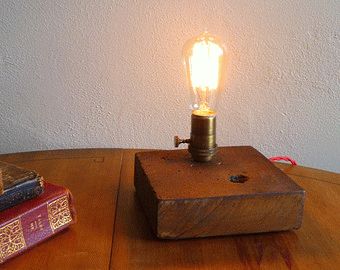
Glassblowers of the 19th century reached professional heights; flasks were easily made. Otto von Guericke, when constructing a static electricity generator, recommended filling a spherical flask with sulfur. The material will harden - break the glass. The result was an ideal ball; when rubbed, it collected a charge, giving it to a steel rod passing through the center of the structure.
Industry pioneers
You can read: the idea of subordinating electricity for lighting purposes was first realized by Sir Humphry Davy. Soon after the creation of the voltaic column, the scientist experimented with metals with all his might. I chose noble platinum for its high melting point - other materials were quickly oxidized by air. They simply burned out. The light source turned out to be dim, providing the basis for hundreds of subsequent developments, showing the direction of movement to those wishing to receive final result: illuminate with the help of electricity.
It happened in 1802, the scientist was 24 years old, later (1806) Humphry Davy presented to the public a fully functional discharge lighting device, in the design of which two coal rods played a leading role. Should be attributed short life such a brilliant luminary in the firmament of science, which gave the world an idea of chlorine, iodine, and a number of alkali metals, led to constant experiments. Lethal experiments on inhalation of carbon monoxide, work with nitric oxide (a powerful toxic substance). The authors saluted the brilliant exploits that shortened the scientist’s life.
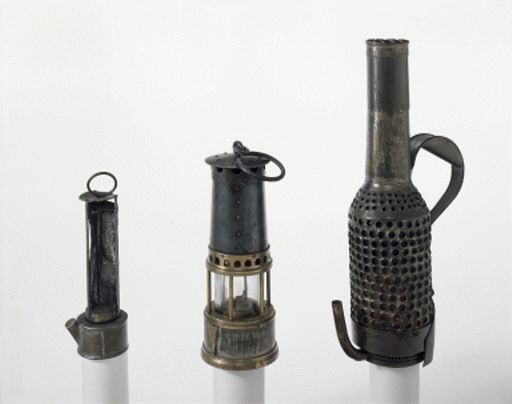
Humphrey abandoned, cutting out a whole decade of research lighting fixtures, always busy. Today Davy is called the father of electrolysis. The Felling Colliery tragedy of 1812 left a deep imprint, darkening the hearts of many. Sir Humphry Davy joined the ranks of those involved in the development of a safe light source that would protect miners. Electricity was scarce and there were no powerful reliable sources of energy. To prevent firedamp from exploding at times, various measures were used, such as a metal mesh diffuser that prevented the spread of flame.
Sir Humphry Davy was far ahead of his time. About 70 years ago. The end of the 19th century brought forth new designs like an avalanche, designed to snatch humanity out of eternal darkness, thanks to the use of electricity. Davy was one of the first to note the dependence of the resistance of materials on temperature, allowing Georg Ohm to later obtain. Half a century later, the discovery formed the basis for the creation of the first electronic thermometer by Carl Wilhelm Siemens.
On October 6, 1835, James Bowman Lindsay demonstrated an incandescent light bulb surrounded by a glass bulb to protect it from the atmosphere. As the inventor put it: one could read a book by dispelling darkness at a distance of one and a half feet from such a source. James Bowman, according to generally accepted sources, is the author of the idea of protecting the filament with a glass bulb. Is it true?
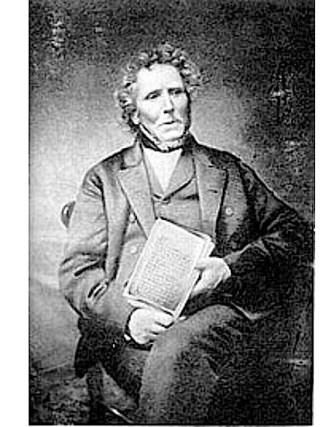
We are inclined to say that in this place world history a little confused. The first sketch of such a device dates back to 1820. For some reason attributed to Warren de la Roux. Who was... 5 years old. A lone researcher noticed the absurdity when he set the date... 1840. A kindergartener is powerless to make such a great invention. Moreover, James Bowman’s demonstrations were forgotten in a hurry. Many historical books(one from 1961, by Lewis) this is how they interpreted the picture that came from out of nowhere. Apparently, the author was mistaken; another source, 1986 by Joseph Stoer, attributes the invention to Augustus Arthur de la Riva (born 1801). Much better suited to explain James Bowman's demonstrations fifteen years later.
It went unnoticed by the Russian-language domain. English sources interpret the problem as follows: the names de la Roux and de la Rive are clearly mixed up and may concern at least four individuals. Physicists Warren de la Roux and Augustus Arthur de la Rive are mentioned; the first attended kindergarten in 1820, figuratively speaking. The fathers of the men mentioned can clarify the story: Thomas de la Roux (1793 - 1866), Charles Gaspard de la Rive (1770 - 1834). An unknown gentleman (lady) conducted a whole study, convincingly proved that the reference to the de la Roux surname is untenable, and referred to a mountain of scientific literature from the early 20th century - late XIX century.
The unknown person took the trouble to look through Warren de la Roux's patents, and there were nine of them. There are no incandescent lamps of the described design. It is difficult to imagine Augustus Arthur de la Riva, who began publishing scientific works in 1822, inventing the glass flask. He visited England, the birthplace of the incandescent light bulb, and studied electricity. Those interested can write to the author of the article on the English-language site at e-mail [email protected]. “Ezhkov” writes: he will be happy to take into account information related to the issue.
The true inventor of the incandescent light bulb
It is reliably known that in 1879 Edison patented (US Patent 223898) the first incandescent light bulb. Descendants recorded the event. Regarding earlier publications, the authorship is questionable. The commutator engine that gave the world the gift is unknown. Sir Humphry Davy refused to take out a patent for the invented safety lamp for the mine, making the invention publicly available. Such whims create considerable confusion. We are powerless to find out who was the first to come up with the idea of placing a filament inside a glass bulb, ensuring the functionality of the design that is used everywhere.
Incandescent lamps are going out of fashion
An incandescent lamp uses a secondary principle of light production. The thread reaches a high temperature. The efficiency of the devices is low, most of energy is wasted. Modern standards dictate the country to conserve energy. Bit bits are in fashion, led light bulbs. Humphry Davy, de la Roux, de la Rive, Edison, who had a hand and worked to pull humanity out of darkness, will forever remain in the memory.
Please note that Charles Gaspard de la Rive died in 1834. The following fall, the first public demonstration took place... Has anyone found the records of the deceased researcher? Time will resolve the question, for everything secret will be revealed. Readers noticed: an unknown force was pushing Davy to try to use the protective flask to help the miners. The scientist's heart turned out to be too big to see the obvious hint. The Englishman had the necessary information...
Analyzing the structure of an incandescent lamp (Figure 1, A) we find that the main part of its structure is the filament body 3 , which heats up under the influence of electric current until optical radiation appears. The principle of operation of the lamp is actually based on this. The filament body is fastened inside the lamp using electrodes 6 , usually holding its ends. Through the electrodes, electric current is also supplied to the filament body, that is, they are also internal links of the terminals. If the stability of the filament body is insufficient, additional holders are used 4 . The holders are mounted on a glass rod by soldering 5 , called a staff, which has a thickening at the end. The post is associated with a complex glass part – the leg. The leg, it is shown in Figure 1, b, consists of electrodes 6 , plates 9 , and shtengel 10 , which is a hollow tube through which air is pumped out of the lamp bulb. General connection between intermediate terminals 8 , staff, plates and rods form a blade 7 . The connection is made by melting the glass parts, during which an exhaust hole is made 14 connecting the internal cavity of the evacuation tube with the internal cavity of the lamp bulb. To supply electric current to the filament through electrodes 6 use intermediate 8 and external conclusions 11 , connected to each other by electric welding.
Figure 1. The structure of an electric incandescent lamp ( A) and her legs ( b)
To insulate the filament body, as well as other parts of the light bulb, from external environment, glass flask is used 1 . The air from the internal cavity of the flask is pumped out, and an inert gas or a mixture of gases is pumped in instead 2 , after which the end of the rod is heated and sealed.
To supply electric current to the lamp and secure it in the electric socket, the lamp is equipped with a base 13 , which is attached to the neck of the flask 1 carried out using capping mastic. The lamp leads are soldered to the appropriate places on the base. 12 .
The light distribution of the lamp depends on how the filament body is located and what shape it is. But this only applies to lamps with transparent bulbs. If we imagine that the filament is an equally bright cylinder and project the light emanating from it onto a plane perpendicular to the largest surface of the luminous filament or spiral, then the maximum luminous intensity will appear on it. Therefore, to create the necessary directions of light forces, in various designs lamps, filaments are given a certain shape. Examples of filament shapes are shown in Figure 2. Straight non-spiral filament is almost never used in modern incandescent lamps. This is due to the fact that with an increase in the diameter of the filament body, heat loss through the gas filling the lamp decreases.

Figure 2. Design of the filament body:
A- high-voltage projection lamp; b- low-voltage projection lamp; V- ensuring obtaining an equally bright disk
A large number of filament bodies are divided into two groups. The first group includes filament bodies used in general-purpose lamps, the design of which was originally conceived as a radiation source with a uniform distribution of luminous intensity. The purpose of designing such lamps is to obtain maximum luminous efficiency, which is achieved by reducing the number of holders through which the filament is cooled. The second group includes the so-called flat bodies filaments, which are made either in the form of parallel spirals (in high-power high-voltage lamps) or in the form of flat spirals (in low-power low-voltage lamps). The first design is made with a large number of molybdenum holders, which are attached with special ceramic bridges. A long filament is placed in the form of a basket, thereby achieving high overall brightness. In incandescent lamps intended for optical systems, the filament bodies must be compact. To do this, the filament body is rolled into a bow, double or triple spiral. Figure 3 shows the luminous intensity curves created by filament bodies of various designs.
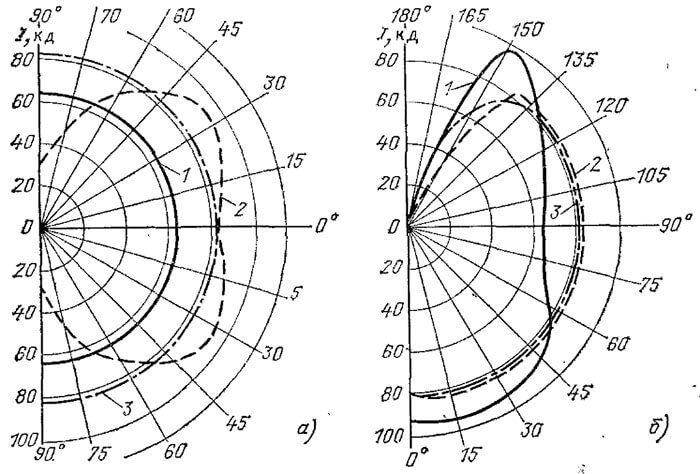
Figure 3. Luminous intensity curves of incandescent lamps with different filament bodies:
A- in a plane perpendicular to the axis of the lamp; b- in a plane passing through the axis of the lamp; 1
- annular spiral; 2
- straight coil; 3
- a spiral located on the surface of the cylinder
The required luminous intensity curves of incandescent lamps can be obtained by using special bulbs with reflective or diffusing coatings. The use of reflective coatings on an appropriately shaped bulb allows for a significant variety of luminous intensity curves. Lamps with reflective coatings are called mirror lamps (Figure 4). If it is necessary to ensure particularly precise light distribution in mirror lamps, bulbs made by pressing are used. Such lamps are called headlight lamps. Some incandescent lamp designs have metal reflectors built into the bulbs.

Figure 4. Mirror incandescent lamps
Materials used in incandescent lamps
Metals
The main element of incandescent lamps is the filament body. To make a filament body, it is most advisable to use metals and other materials with electronic conductivity. In this case, by passing an electric current, the body will heat up to the required temperature. The material of the filament body must satisfy a number of requirements: have a high melting point, plasticity, allowing drawing wire of various diameters, including very small ones, low speed evaporation at operating temperatures, resulting in a high service life, and the like. Table 1 shows the melting temperatures of refractory metals. The most refractory metal is tungsten, which, along with high ductility and low evaporation rate, has ensured its widespread use as the filament of incandescent lamps.
Table 1
Melting point of metals and their compounds
| Metals | T, °С | Carbides and their mixtures | T, °С | Nitrides | T, °С | Borides | T, °С |
| Tungsten Rhenium Tantalum Osmium Molybdenum Niobium Iridium Zirconium Platinum | 3410 3180 3014 3050 2620 2470 2410 1825 1769 | 4TaC+ +HiC 4TaC+ +ZrC HfC TaC ZrC NbC TiC W.C. W2C MoC VnC ScC SiC | 3927 3887 | TaC+ + TaN HfN TiC+ + TiN TaN ZrN TiN BN | 3373 3087 | HfB ZrB W.B. | 3067 2987 2927 |
The evaporation rate of tungsten at temperatures of 2870 and 3270°C is 8.41×10 -10 and 9.95×10 -8 kg/(cm²×s).
Among other materials, rhenium can be considered promising, the melting point of which is slightly lower than that of tungsten. Rhenium lends itself well machining when heated, it is resistant to oxidation and has a lower evaporation rate than tungsten. There are foreign publications on the production of lamps with tungsten filament with rhenium additives, as well as coating the filament with a layer of rhenium. Of the non-metallic compounds, tantalum carbide is of interest, the evaporation rate of which is 20 - 30% lower than that of tungsten. An obstacle to the use of carbides, in particular tantalum carbide, is their fragility.
Table 2 shows the main physical properties perfect body filament made of tungsten.
table 2
Basic physical properties of tungsten filament
| Temperature, K | Evaporation rate, kg/(m²×s) | Electrical resistivity, 10 -6 Ohm×cm | Brightness cd/m² | Luminous efficacy, lm/W | Color temperature, K |
| 1000 1400 1800 2200 2600 3000 3400 | 5.32 × 10 -35 2.51 × 10 -23 8.81 × 10 -17 1.24 × 10 -12 8.41 × 10 -10 9.95×10 -8 3.47×10 -6 | 24,93 37,19 50,05 63,48 77,49 92,04 107,02 | 0,0012 1,04 51,2 640 3640 13260 36000 | 0,0007 0,09 1,19 5,52 14,34 27,25 43,20 | 1005 1418 1823 2238 2660 3092 3522 |
An important property of tungsten is the possibility of producing its alloys. Parts made from them retain a stable shape when high temperature. When heating the tungsten wire, in the process heat treatment filament body and subsequent heating there is a change in its internal structure, called thermal recrystallization. Depending on the nature of recrystallization, the filament body may have greater or less dimensional stability. The nature of recrystallization is influenced by impurities and additives added to tungsten during its manufacturing process.
The addition of thorium oxide ThO 2 to tungsten slows down the process of its recrystallization and provides a fine-crystalline structure. Such tungsten is strong under mechanical shocks, but it sags greatly and is therefore not suitable for the manufacture of filament bodies in the form of spirals. Tungsten with a high thorium oxide content is used to make cathodes gas discharge lamps due to its high emissivity.
For the manufacture of spirals, tungsten with an additive of silicon oxide SiO 2 is used together with alkali metals- potassium and sodium, as well as tungsten, containing, in addition to those indicated, the additive of aluminum oxide Al 2 O 3. The latter gives the best results in the manufacture of bispirals.
The electrodes of most incandescent lamps are made of pure nickel. The choice is due to the good vacuum properties of this metal, which releases gases sorbed in it, high conductive properties and weldability with tungsten and other materials. The malleability of nickel allows welding with tungsten to be replaced by compression, which provides good electrical and thermal conductivity. In incandescent vacuum lamps, copper is used instead of nickel.
The holders are usually made of molybdenum wire, which retains elasticity at high temperatures. This allows the filament body to be maintained in an extended state even after it expands as a result of heating. Molybdenum has a melting point of 2890 K and a temperature coefficient of linear expansion (TCLE), in the range from 300 to 800 K equal to 55 × 10 -7 K -1. Molybdenum is also used to make inserts into refractory glass.
Terminals of incandescent lamps are made from copper wire, which is end welded to the inputs. Low-power incandescent lamps do not have separate terminals; their role is played by elongated terminals made of platinite. To solder the leads to the base, tin-lead solder of the POS-40 brand is used.
Glass
Stems, plates, rods, flasks and other glass parts used in the same incandescent lamp are made of silicate glass with the same temperature coefficient of linear expansion, which is necessary to ensure the tightness of the welding points of these parts. The values of the temperature coefficient of linear expansion of lamp glasses must ensure the formation of consistent junctions with the metals used for the manufacture of bushings. The most widely used glass is the SL96-1 brand with a temperature coefficient value of 96 × 10 -7 K -1. This glass can operate at temperatures from 200 to 473 K.
One of important parameters glass is the temperature range within which it retains weldability. To ensure weldability, some parts are made from SL93-1 glass, which differs from SL96-1 glass chemical composition and a wider temperature range in which it retains weldability. SL93-1 glass is characterized by a high content of lead oxide. If it is necessary to reduce the size of the flasks, more refractory glasses are used (for example, grade SL40-1), the temperature coefficient of which is 40 × 10 -7 K -1. These glasses can operate at temperatures from 200 to 523 K. The highest operating temperature is quartz glass of the SL5-1 brand, incandescent lamps from which can operate at 1000 K or more for several hundred hours (temperature coefficient of linear expansion of quartz glass is 5.4 × 10 -7 K -1). Glass of the listed brands is transparent to optical radiation in the wavelength range from 300 nm to 2.5 - 3 microns. The transmission of quartz glass starts at 220 nm.
Inputs
The bushings are made of a material that, along with good electrical conductivity, must have a thermal coefficient of linear expansion, ensuring the formation of consistent junctions with the glass used for the manufacture of incandescent lamps. The junctions of materials are called consistent, the values thermal coefficient linear expansion of which in the entire temperature range, that is, from the minimum to the glass annealing temperature, differs by no more than 10 - 15%. When soldering metal into glass, it is better if the thermal coefficient of linear expansion of the metal is slightly lower than that of glass. Then, when the solder cools, the glass compresses the metal. In the absence of metal with the required value of the thermal coefficient of linear expansion, it is necessary to make unmatched joints. In this case, a vacuum-tight connection between metal and glass over the entire temperature range, as well as the mechanical strength of the solder, are ensured by a special design.
A matched junction with SL96-1 glass is obtained using platinum leads. The high cost of this metal led to the need to develop a substitute, called “platinite”. Platinite is a wire made of an iron-nickel alloy with a thermal coefficient of linear expansion lower than that of glass. By applying a layer of copper to such a wire, it is possible to obtain a highly conductive bimetallic wire with a large thermal coefficient of linear expansion, depending on the thickness of the layer of applied copper layer and the thermal coefficient of linear expansion of the original wire. Obviously, this method of matching the temperature coefficients of linear expansion makes it possible to match mainly the diametrical expansion, leaving the temperature coefficient of the longitudinal expansion unmatched. To ensure better vacuum density of the joints of SL96-1 glass with platinite and to enhance wettability over a layer of copper oxidized over the surface to cuprous oxide, the wire is coated with a layer of borax (sodium salt boric acid). Sufficiently strong solders are ensured when using platinum wire with a diameter of up to 0.8 mm.
Vacuum-tight soldering into SL40-1 glass is obtained using molybdenum wire. This pair gives a more consistent connection than SL96-1 glass with platinite. The limited use of this solder is due to the high cost of raw materials.
To obtain vacuum-tight leads in quartz glass, metals with a very low thermal coefficient of linear expansion are required, which do not exist. Therefore, I get the required result thanks to the input design. The metal used is molybdenum, which has good wettability with quartz glass. For incandescent lamps in quartz flasks, simple foil bushings are used.
Gases
Filling incandescent lamps with gas allows you to increase the operating temperature of the filament body without reducing the service life due to a decrease in the rate of tungsten sputtering in a gaseous environment compared to sputtering in a vacuum. Spray rate decreases with increasing molecular weight and filling gas pressure. The filling gas pressure is approximately 8 × 104 Pa. What gas should I use for this?
The use of a gas medium leads to heat losses due to thermal conductivity through the gas and convection. To reduce losses, it is advantageous to fill lamps with heavy inert gases or their mixtures. These gases include nitrogen, argon, krypton and xenon obtained from air. Table 3 shows the main parameters of inert gases. Nitrogen in its pure form is not used due to big losses associated with its relatively high thermal conductivity.
Table 3
Basic parameters of inert gases

